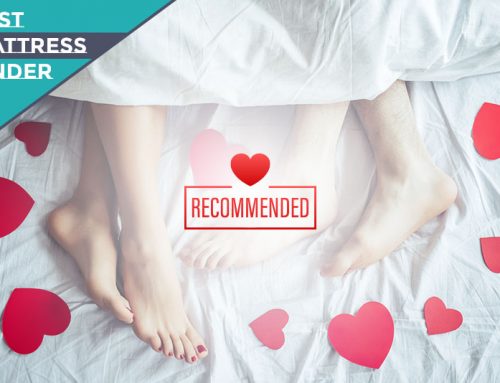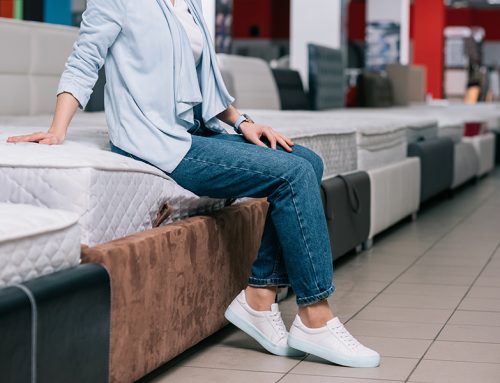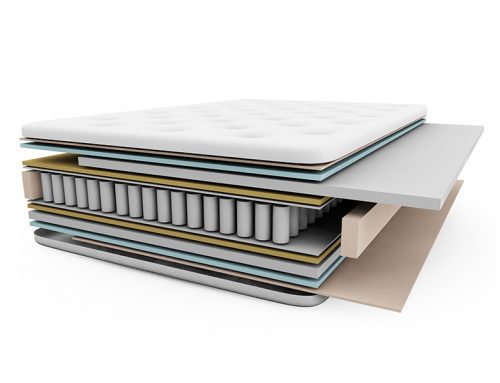It’s a debate more polarizing than a US election primary, with an outcome that’s almost as subjective: should you opt for a soft, luxuriating mattress, which makes you feel like you’re sinking into a cloud of feathers? Or, should you be considering a firm, supportive mattress, which keeps you expertly aligned and perfectly cool throughout the night? Whichever side you lie on, this post should help make things a little clearer.
The case for a soft mattress
The first moments of lying on a soft mattress make for a powerful sales pitch. As long as the mattress is properly constructed (i.e. it’s soft, but not overly giving) that feeling of sinking into a plush material can make the choice of firm Vs soft seem like a no-brainer.
Spend a few hours on that same mattress, however, and while some sleepers will continue to revel in luxury, others will emerge stiff and grumpy, complaining about lower back pain and a ‘lack of support.’
The truth is that all well-made mattresses, even soft ones, are not ‘lacking in support’. Rather, our bodies respond differently according to how apparent that support is, with some of us preferring more cushion above a supportive base, while others like to feel that a stable core is working beneath to support their body.
Whether made of springs or foam (or both), a soft mattress will begin its life with a similar, or perhaps even identical, foundation as a firm mattress. Manufacturers invest in the design of their foundation layers in order to ensure the long-term reliability of their products, with the latest cores ranging from innerspring or pocket coils through to tough polyurethane foam, and even latex.
On top of that core, a soft mattress will usually play host to an impressive series of comfort layers. These are designed to capture the perfect amount of ‘sinking’ at various weights. Layers will usually be made of foam, including memory foam, and will allow your hips and head to sink to the lower level of the supportive core, while your limbs and lighter parts of the body stay floating on the comfort toppers.
Note: There’s a big difference between ‘soft’ and ‘give’. No matter how soft a mattress gets, it should always provide a fundamental level of support for your shoulders, lower back, and hips.
So when we say ‘soft mattress,’ we’re not talking about anything that bends, sags, or gives way. No one (I think) wants to spend a night on that kind of bed. Instead, by ‘soft mattress,’ we mean a properly constructed sleeping surface that’s more focused on comfort than it is on firmness.
Forget soft—what you really need is a firm mattress
On the other side of the spectrum, replace those comfort layers with an optimized, slimmed-down, and more communicative set of materials, and you have yourself a firm mattress. As for why you might want to sacrifice softness for an increased awareness of the mattress working underneath your body, there’s a sizeable contingent of sleepers who swear by the healing effects of a firm sleeping surface, helping to take the pressure off tired and overused joints and giving the spine a chance to release after a long day.
A 2002 study of firmness in different bedding systems that focused on quality of sleep, low back pain, shoulder pain, and spine stiffness found that medium-firm mattresses reduced pain in clinically diagnosed back, shoulder, and spine conditions, as well as increasing sleep quality. The study goes as far as stating that a sufficiently firm mattress can improve even minor sleep disturbances, making your 7 to 9 hours more efficient and consistent.
Even though there are no universal or official guidelines on mattresses, 75% of orthopedic surgeons do recommend a firm or hard mattress for those suffering from back pain, making the consensus a little mixed, but overall skewed towards the medium-firm level. Over time, so the theory goes, the support of a firm mattress—though importantly, not over firm—will help to relax deep muscles, encourage better sleep, and even improving posture. Pick a mattress that doesn’t sufficiently take the weight off, however, and you could be waking up throughout the night with increased pain, particularly in the lower back area.
Note: Many mattress shoppers end up going home with a firmer mattress than they originally envisioned. One reason for this is that mattresses inevitably soften over time. Therefore, starting with a mattress that’s already soft can lead to a shorter shelf life than a firmer model.
Likewise, couples often plump for a firmer model to avoid the dreaded ‘roll’ towards the center of the bed, which can occur on a soft surface when one sleeper is significantly heavier than the other. However, it’s important never to sacrifice the correct level of spinal support in the name of durability.
How to match a mattress to your needs (a match-tress made in heaven…?)
Finding the mattress of and for your dreams requires spending some time thinking about what sort of surface your body would most benefit from. There are a few relevant criteria here, such as your weight and whether you share a bed—but the key factors are the position in which you normally sleep and the health of your spine.
Sleep position
If you sleep primarily on your side, you might find a softer mattress more comfortable. Side sleeping creates pressure points where your body makes contact with the surface of the bed—particularly the shoulders and hips. Having those extra comfort layers helps redistribute the pressure. Additionally, a softer mattress will also conform more to the way your body curves on its side. Soft mattresses are also recommended for lighter individuals, whose weight means they can compress a harder mattress, no matter what position they sleep in.
For stomach and back sleepers, the same logic suggests a firm mattress is generally better. This is because a firm surface will provide a more even weight distribution when you’re lying symmetrically. Here is a roundup of the best mattresses for stomach sleepers. Likewise, heavier people will be able to fully compress a firmer mattress, accessing the different support levels at different weights.
Spine health
Much of the decision on a firm vs soft bed comes down to one part of your body: your spine, and the condition it tends to be in.
Mattress designers are always attempting to retain the natural, neutral curves of your spine, without over-compressing them, or demanding that they’re left completely flat. When you’re laying with the spine properly aligned, your head, shoulders, and hips feel pleasantly weighty, while the rest of your body is free from any pressure. A common test for this alignment is to feel as if you’re floating on the surface of the bed.
Because of this, a soft mattress is normally more appealing for those who’s spine needs a more forgiving treatment. In 2014, The Canadian Agency for Drugs and Technologies in Health carried out a summary of research into the relationship between mattress firmness and lower-back and neck pain. Based on a sample criteria of patients between the ages of 18 and 60 years with stable chronic low back pain, the summary concluded that firm and extra-firm mattresses can impede alignment and exacerbate pain in the back and legs pain as well as cause a “decrease in reported sleep hours.”
For those not experiencing troublesome back pain, on the other hand, a firm mattress will generally be more comfortable. When sleeping on a firmer surface, pressure on the muscles and organs is alleviated, shifting weight onto your bone structure. With your bones taking your weight, your body is free to breathe, increasing circulation, muscle conditioning, and oxygenation. Similarly, the way that a firm mattress will stop your lower back from arching outwards is thought to promote deeper respiration, giving your lungs and core more room to maneuver.
The best soft mattress construction
Today’s premium soft mattress market is awash with talk about foam. Several foam technologies have been introduced in recent years, to varying levels of success, the most famous of which being memory foam. Famous for its origins in a NASA-funded lab, memory foam has long been the gold-standard for soft-mattresses, for its ability to conform to the body’s shape upon coming into contact with weight and heat.
Modern types of memory foam include gel-infused foam layers, which combine foam with gel microbeads, creating a more breathable surface that improves temperature regulation without sacrificing softness. Charcoal, copper, and aloe infusions give similar insulating and microbial results.
More traditional soft options are still out there, and worth considering—especially at higher price points. While a bog-standard innerspring mattress might be the stuff of sagging nightmares, springs combined with a memory foam comfort layer add even more sumptuous sinkage.
It’s also worth pointing out that many manufacturers will create bespoke double, queen, and king size beds with different levels of firmness on each side. So if you share a bed with somebody who has a radically different set of mattress needs than you, it’s possible for you both to get the support you need.
Perhaps you’re a lighter person with a sensitive lower back—who therefore needs a softer mattress—while your partner is heavier with a more robust spine, who may find your soft side sinks in too much for them.

The best firm mattress construction
If firmness is your thing, some firmer types of memory foam may work for you. But, in general, you want to be looking at innovative spring constructions with comfort layers specifically designed for firmness.
Today, many manufacturers are switching to latex as a top layer, bringing responsiveness of foam without the risks of sinkage or heat retention. Others are creating their own iterations of polyurethane, tweaking the material formula to produce branded foams.
Spring-wise, look for configurations that connect coils together or otherwise keep them from shifting position over time. At the higher end of the market, a quality pocket spring product will leave you sleeping like firm-mattress royalty.
Or, you could be really hardcore and forget the mattress entirely. Floor Sleeping has been a growing wellness trend for several years, offering the ultimate in firm sleeping through a simple mat, camping pad, or just the honest ground as a bed. The trend is not without some evidential backing.
Floor sleeping evangelists such as Katy Bowman, M.S., who’s profiled in this Men’s Health article, claim that many of the aches and pains we encounter as we rise in the morning are actually due to the way that modern mattresses encourage us to lie still for hours every night. However, even those who extol the virtues of floor sleeping don’t recommend swapping a mattress for the floor without a lengthy transition period.
Conclusion
There are no universal guidelines on the best mattress, but whether you’re concerned about meeting the needs of a fragile lower back, or you’re just looking to improve the quality of your sleep, there are some key takeaways to be had:
In general, the better your posture, the harder the mattress you can accommodate.
If you suffer from lower back or neck pain, steer clear of a very firm mattress. Instead, look into soft to medium-firm models, which will help shift pressure from your muscles and onto your bone structure.
Side sleepers are normally more receptive to softer mattresses, which reduce pressure points, while back and stomach sleepers find it easier to spread out on a firm surface.
For the best in soft mattresses comfort, try a memory foam design. Look for manufacturers combining temperature regulation technology with a focus on comfort, as pure memory foam has a reputation for holding in heat throughout the night.
For a competitively-priced foam mattress, try out models with thick poly-foam mid and comfort layers, as well as those with individually wrapped inner springs. As a general rule, you’re looking for a product that keeps all its parts static and stable.
A ‘soft mattress’ shouldn’t mean cheap or flimsy. Both firm and soft mattresses need to come with a well-engineered core layer of support. Refer to our guide to choosing the best mattress that suits your needs.





